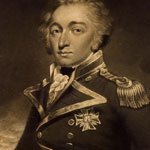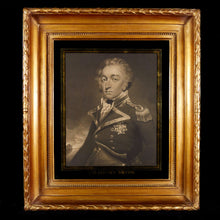Mezzotint - Sir William Sidney Smith, R.N.,1796
- Regular price
- £975
- Sale price
- £975
- Regular price
-
- Unit price
- /per
Adding product to your cart
Measurements: Overall: 48cm (18.8in) x 42cm (16.5in)
Mezzotint. Half length facing left, in uniform coat and wearing the breast star of the Swedish Grand Cross of the Svärdsorden. After J.W. Bell. Engraved and published by Edward Bell. Image: 28.5cm (11.2in) x 23cm (9in). Titled in gilt ‘Sir Sidney Smith’ on the verre-eglomisé mount. Period giltwood frame.
Admiral Sir Sidney Smith (1764-1840) liked to think of himself as a second Nelson, and there are certainly parallels between the two. Most notably Smith and Nelson shared the credit for ending Napoleon’s dream of eastern conquest: Nelson at the Battle of the Nile and Smith by his defence of Acre in 1799. Moreover, Napoleon reminiscing late in his life, said of Smith: ‘That man made me miss my destiny’. Smith’s long and active career was shaped by a willingness to act on his initiative. He distinguished himself in action at a young age during the American Revolutionary War, and afterwards undertook intelligence gathering missions in France, Spain and Morocco, before entering Swedish service and leading King Gustav’s fleet to victory with destruction of sixty-four Russian ships in 1790. There were a number of British officers, on half pay like Smith, serving with the Russian fleet and six were killed in this action. As a result, Smith earned the enmity of many British naval officers for his Swedish service.
Read more
In 1792 Smith travelled to the Grande Porte where his brother was the British envoy and established good relations with the Ottoman court. Following the outbreak of war with Revolutionary France he appeared as a volunteer at burning of the French fleet at Toulon, and was later captured on the northern French coast during a cutting out expedition. He later escaped from the Temple prison in Paris. On his return to London, Smith was given command of the fifth-rate H.M.S. Diamond and in 1795 joined the Western Frigate Squadron under Sir John Borlase Warren. This squadron consisted of some of the most skilful and daring captains of the day, occupied the Îles Saint-Marcouf off the coast of Normandy. He sacrificed two of his gun vessels, H.M.S. Badger and H.M.S. Sandfly, to provide materials and manpower for fortifying the islands and setting a temporary naval garrison. Further defences were constructed by Royal Engineers, and Royal Marines and Royal Artillery detachments were established. The islands served as a forward base for the blockade of Le Havre, a launching point for intercepting coastal shipping, and as a transit point for French émigrés, and were held by the Navy for nearly seven years.
In April 1796, he and his secretary John Wesley Wright were captured while attempting to cut out a French ship in Le Havre. Smith was charged with arson for his burning of the fleet at Toulon and was held in Paris for two years. The French authorities threatened to try him, but never brought him to court. Eventually in 1798 he escaped with the help of Royalists, who pretended to be taking him to another prison. The royalists brought the two Englishmen to Le Havre, where they boarded an open fishing boat and were picked up on by H.M.S. Argo on patrol in the English Channel, arriving in London on 8 May 1798. In 1806 he was in Italy and led land forces to victory over the numerically superior French at the Battle of Maida, In 1815 he was at Brussels during the Battle of Waterloo and afterwards negotiated the uncontested entry of the British Army into Paris.






